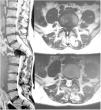Cauda equina syndrome (CES) caused by lumbar disk extrusion is classically considered an indication of urgent surgery. CES can be subdivided into CESI (incomplete CES) and CESR (complete CES with urinary retention and incontinence). This paper evaluates the long-term functional outcome of a CES cohort operated on due to disk herniation.
MethodsSingle-center retrospective observational study. CES patients due to disk herniation that underwent surgery between 2000 and 2016 were included in the study. Demographic data, time intervals to diagnosis and surgery, preoperative neurologic status and outcome at the end of follow up were recorded.
ResultsTwenty-two patients were included (median age 44 years). Eight patients were CESR and 14 CESI. Median time from symptom onset to diagnosis was 78h (range, 12–720h), and from diagnosis to surgery 24h (range, 5–120h). Median follow up was 75 months (range, 20–195 months). At the end of follow up, in the CESR group (median time from diagnosis to surgery, 23h) only pain significantly improved after surgery (p=0.007). In the CESI group (median time from diagnosis to surgery 23h) low back pain, sciatica and urinary sphincter function significantly improved (p<0.001). There were no significant differences between early (<48h) operation (n=4) and late (n=18) in terms of sphincter recovery (Fisher's Exact Test, p=0.076).
ConclusionPain associated to CES improved both in the CESI and CESR groups. However, urinary sphincter impairment significantly improved only in the CESI group. No significant differences were found regarding long-term functional outcome between early and late surgery.
El síndrome de cola de caballo (SCC) producido por extrusión discal se ha considerado clásicamente una urgencia neuroquirúrgica. El SCC puede dividirse en SCC-I (incompleto) y en SCC-C (completo, con retención urinaria e incontinencia). Este trabajo evalúa el pronóstico funcional a largo plazo de una cohorte de pacientes con SCC por hernia discal intervenidos.
Material y métodosEstudio observacional retrospectivo unicéntrico. Se incluyeron todos los pacientes diagnosticados de SCC por hernia discal e intervenidos en el período 2000-2016. Se recogieron datos demográficos, intervalos de tiempo entre el inicio de síntomas, el diagnóstico y la cirugía, y estado neurológico preoperatorio y al final del seguimiento.
ResultadosSe incluyeron un total de 22 pacientes (edad mediana de 44 años). Ocho casos fueron SCC-C y 14 SCC-I. El tiempo medio desde el inicio de los síntomas hasta el diagnóstico fue de 78h (rango, 12-720h), y desde el diagnóstico hasta la cirugía de 24h (rango, 5-120h). El seguimiento mediano fue de 75 meses (rango, 20-195). Al final del seguimiento, en el grupo SCC-C (tiempo medio desde diagnóstico hasta la cirugía, 23h) sólo el dolor mejoró de forma significativa tras la cirugía (p = 0,007). En el grupo SCC-I (tiempo medio desde diagnóstico hasta la cirugía, 23h) mejoraron significativamente el dolor lumbar, la ciática y el control del esfínter urinario (p < 0.01). No se constataron diferencias significativas entre los operados precozmente (antes de 48h, n = 4) y tardíamente (n = 18) en relación a la recuperación esfinteriana (Test exacto de Fisher, p = 0,076).
ConclusiónEl dolor asociado al SCC mejoró tanto en los casos completos como incompletos. Sin embargo, el control del esfínter urinario sólo mejoró significativamente en los pacientes con síndromes incompletos. No se encontraron diferencias significativas en cuanto al resultado funcional a largo plazo entre intervenidos precoz y tardíamente.
Article

If it is the first time you have accessed you can obtain your credentials by contacting Elsevier Spain in suscripciones@elsevier.com or by calling our Customer Service at902 88 87 40 if you are calling from Spain or at +34 932 418 800 (from 9 to 18h., GMT + 1) if you are calling outside of Spain.
If you already have your login data, please click here .
If you have forgotten your password you can you can recover it by clicking here and selecting the option ¿I have forgotten my password¿.















